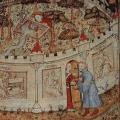255. Andreas Speer on Medieval Aesthetics
Posted on
Does medieval art tell us anything about medieval theories of aesthetics? Peter finds out from Andreas Speer.
Themes:
Further Reading
Prof Speer's website with a (long!) list of his publications. For his work on medieval aesthetics see for instance:
• A. Speer, "Art as Liturgy. Abbot Suger of Saint-Denis and the Question of Medieval Aesthetics", in: J. Hamesse (ed.), Roma, magistra mundi. Intineraria culturae mediaevalis (Louvain-la-Neuve: 1998), 855-75.
• A. Speer, "Beyond Art and Beauty. In Search of the Object of Philosophical Aesthetics", International Journal of Philosophical Studies 8 (2000), 73-88.
• A. Speer, "Aesthetics", in: J. Marenbon (ed.), The Oxford Handbook of Medieval Philosophy (Oxford: 2012), 661-84.







Comments
Thanks
Thanks for this theme and the episode.
I think "les beaux arts" are partly a romantic invention but we need this label even when we are looking in and understanding the past.
German word?
I have very little German and was unable to catch the German word Speer used when he as talking about Hegelian "inersection of art and beauty." Could anyone please tell me what the word was?
In reply to German word? by Larry from Tacoma
German
I'm sure I can help you decipher it - do you know at what minute it is in the podcast, to help me find the place?
In reply to German by Peter Adamson
Thank you!
Thank you!
It's a bit past 7 minutes 15 seconds.
In reply to Thank you! by Larry from Tacoma
ars pulchra
Actually he is saying "ars pulchra" there - Latin, not German. I guess that "fine art" is the best translation.
In reply to ars pulchra by Peter Adamson
Thank you very much! Now I
Thank you very much! Now I can hear it.
By the way, big fan of the podcasts, & I thought this episode was especially interesting. I always love the interviews (& everything else).
Medieval Aesthetics
Thanks so much, Peter, for the episode. Here is my understanding synopsized. Any comments most appreciated.
Medieval aestheics usually is viewed by such writers as Eco in terms of transcendental beauty expressing itself in Light, Proportion and Symbol & Allegory. (I hear echoes of Plotinus' chapter 9 on Beauty with light and proportion. Andreas Speer thinks this way of seeing through a modeern, Hegelian lens (ideas first; materials second) is simply not accurate.
Rather, after investigating the actual record of constructions of cathedrals and other objects now found in modern museums, things like statues and religious paintings, those medieval artisans were very "earthy" creators, working with materials ina specific location and what was ultimately created was very practical and an organic outgrowth site specific.
Andreas Spper also noted how individual medieval craftsman would "sign" their work but more than anything each individual's identity was more entwined in a group or guild. And, of course, people in the medieval world were not viewing these works as objects of fine art set off from the everyday world in an objective way (as per aesthetic theories of thinkers like Kant and Schopenhauer) but were seeing those works as within the fabric of their day-to-day lives and supports for their Church centered religion.
In reply to Medieval Aesthetics by Glenn Russell
Aesthetics
Thanks, I think that sums it up quite well! Or at least part of what he said, it's a very rich interview and subject, I think. One other thing I took away from is that he defines the topic not only by negatively rejecting the Hegelian approach, as you mention, but with a more positive approach of thinking about medieval aesthetics as dealing with, effectively, the original meaning and purpose of objects we would _now_ consider to be art, even if they were not categorized as such back then. That was very interesting, I found.
In reply to Aesthetics by Peter Adamson
Medieval Aesthetics
Thanks very much for your post here, Peter. Yes, a very rich subject! If there was a entire course devoted to medieval aesthetics I'd be the first person to sign up!
Thinking about medieval aesthetics dealing with, effectively, the original meaning and purpose of objects we would now consider to be art --------- Yes, big difference in the way they viewed objects. Nowadays we would put a finely crafted gargoyle in a glass case in a museum where visitors could view in detail close up. Back then, the gargoyle was high up, doing its job during a rain as a water-spitter. If people down below couldn't see the detail, that's the way it goes. As I understand, those stone carvers could really stretch their imagination with gargoyles; even if the townspeople couldn't see them up close, their fellow stone carvers could, when they were on the ground or in the shop being carved. (This according to a art historian specializing in the subject).
Prof. Speer website link
Dear Peter,
I hope that all is well. I returned to this page to find Prof. Speer's site info. The link appears to be dead and I didn't have luck searching. Any chance you have a way to contact him to find out the new link?
I haven't purchased the Marebon edited book yet, but it's on the long-term list.
Many thanks,
Dave
In reply to Prof. Speer website link by Dave Lavery
Speer website
Thanks for letting me know! I have updated the link but it is at:
https://thomasinstitut.uni-koeln.de/mitarbeiterinnen/andreas-speer
Add new comment